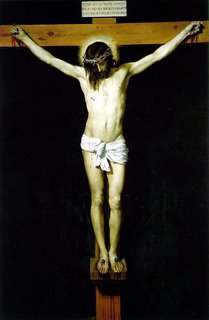
The entire life of Christ is with a view to "his hour." The hour of Jesus is the hour when he fully accomplishes his mission, which is to glorify the Father and save us. It is for this reason that he came. "Behold why I have come to this hour, Father, glorify your name." (John 12:27-28) "Father, the hour has come. Glorify your Son that your Son might glorify you." He came to glorify the Father and to save us. It is the mystery of the Cross which unites this contemplative gaze (glorifying the Father) with the apostolic work par excellence (saving us). It is the will of the Father that this be realized by means of the suffering of the Cross, and the suffering of the Agony where there is sadness (there is no true suffering without the interior sadness of the soul, Therese tells us), sadness such that Jesus could have died from it, "My soul is sad to the point of death." This sadness-- which takes hold of Christ's entire soul-is sadness caused by the weight of sin, by the horror of sin whereby man turns from God and turns in on himself: the sin of personal pride and/or the sin of collective pride (symbolized by the tower of Babel). The mystery of the Cross begins with the Agony and continues to Golgotha. Between the two there is the scourging at the pillar, the carrying of the cross, and the various forms of suffering that Jesus experienced because of the Crucifixion.
Why did God, in his wisdom, wish to unite, in the mystery of the Cross, love in its greatest, most powerful and purest aspect with suffering, with sadness? It is because of the wisdom of the Cross that the Little Flower [St. Therese] unites so closely and constantly love and suffering in an extremely practical and simple fashion. ... Why does the Father--who sends his Son to glorify and save us--establish a connection between love and suffering, extreme suffering, that is, suffering which leads to and implies death. Why does the Father unite love and the deadly sadness of the Agony? Why is this? It would have been more normal to unite love with joy, with success. Jesus would have been capable of succeeding. He would have been able to bring salvation to humanity with the triumphal entry into Jerusalem, or with the amazing procession shown in Chapter six of John's gospel, when Jesus is followed by a crowd of 5,000 men, not including the women and children. Salvation could have been given there. Indeed, none of these things are extrinsic to salvation, but they are not Jesus' "hour," the moment for which he came. His hour is an act of love realized by means of the sadness of the Agony, the suffering of the Cross and the offering of his earthly life, in obedience to the Father.
Let us understand that the Cross, with all the suffering it entails, is a passage whose end is joy. Its end is not sadness, its end is not suffering (that is why suffering does not finalize). Its end is love that blossoms in joy. This blossoming is the mystery of the Resurrection. "If Christ is not risen, vain is our faith" (1 Cor. 15:17). Exteriorly, the Cross is a failure, the most horrible failure that ever existed on earth: amongst the 12 disciples of Jesus there is a traitor, one whom Jesus chose to be his successor who betrays him, and the others flee...save one. Only one of 12, John, is present at the Cross. What would be said of a Novice Master who had formed 12 novices amongst whom only one remained faithful? We would pity him: "Poor novice master. What an idiot; he understood nothing." Exteriorly, the Cross is a horrible failure, and the devil is convinced it is his great victory. In reality, the Cross is the victory of love, a hidden victory: the grain of wheat must fall to the earth to bear much fruit. Here, one touches the fruitfulness of love-- not only love, but the fruitfulness of love. So that there be this fruitfulness of love, we must pass through the Cross, a difficult passage which Jesus indicates for us, but only a passage, whose end is the Resurrection.
1 comment:
St. Cyril of Jerusalem from his Catechetical Lectures, 13, c. 28: "He extended his hands on the Cross in order to embrace the universe."
Post a Comment